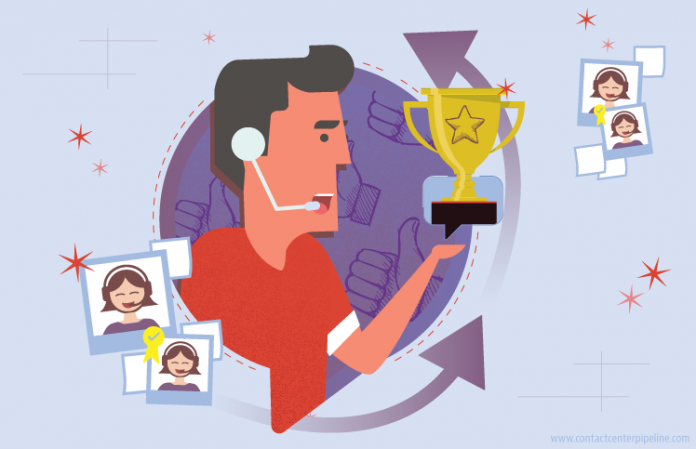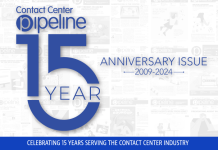
In the contact center, recognition for a job well done does wonders for boosting morale and motivation. Research by the Society for Human Resource Management (SHRM) has confirmed that effective recognition programs also have a positive impact on retention and recruitment, two critical challenges for many contact centers.
The SHRM survey, “Using Recognition and Other Workplace Efforts to Engage Employees,” found that recognition is most impactful when the programs are aligned with an organization’s values and talent strategy. In fact, the majority of survey participants cited the top reasons behind their recognition program design included empowering employees to recognize and feel recognized across the organization (82%); creating a positive employer brand (60%); and reinforcing and driving strategic business goals (48%).
According to SHRM’s “Managing Employee Recognition Programs” Toolkit, a well-managed recognition program not only boosts employee engagement and productivity, but it can also help to elevate an employer’s brand, providing an edge over competitors when it comes to recruiting and retention.
Simple, Yet Effective Ideas for Recognizing Your Agents
To ensure a positive impact on engagement, performance and retention, recognize your team frequently using multiple approaches. Strive for a personalized approach rather than one-size-fits-all. Recognition is more powerful when it is meaningful to the individual. Some agents may respond well to public praise, while others might appreciate a simple, yet sincere thank-you note from a company executive.
Over the years, a good many contact center experts have shared with Pipeline their valuable tips for recognizing frontline staff. The following are a few easy, yet effective recognition ideas that you can put into practice in your center.
SHOW AGENTS THAT YOU VALUE THEIR INPUT
Demonstrating to employees how much they’re valued doesn’t have to be a formal process, according to Malcolm Angell, Manager, Customer Contact, Organizational Services, City of Gold Coast Queensland, Australia. “I regularly ask my team for their suggestions for improving work processes and, where possible, acknowledge and take on board their feedback,” he says.
TAKE THE TIME TO RECOGNIZE A JOB WELL DONE
“The No. 1 incentive-based reward I know of… recognition from management for a job well done,” says Pipeline columnist and PowerHouse Consulting Chief Vision Officer Kathleen Peterson. “It takes but a few seconds to whisper an encouraging word, write a quote or quick note on interesting paper, or place a stick of gum or candy on someone’s chair. The world is full of folks too busy or too unaware to bother. We live in a world where self-absorption has been elevated to an art form. Well, it doesn’t work in busy and demanding operations like contact centers.”
OFFER POSITIVE REINFORCEMENT FOR STEPS TOWARD A GOAL
It’s essential to recognize agents when they achieve a goal, but recognizing their progress toward a goal encourages agents to stay on the path, says O.C. Tanner’s Jordan Rogers. For example, let’s say that you set an FCR goal of 90% for an agent who’s currently hitting 80%. It’s important to recognize the checkpoints along the way—say, when the agent hits 83%, 85% and 87%. Once the agent has achieved the final goal, it should be a separate recognition event—a chance to pause and celebrate their accomplishment.
RECOGNIZE AGENTS’ CAREER MILESTONES
Similar to reinforcing steps toward a goal, recognize the milestones in an agent’s career.
“It’s important to take all of these moments over time in someone’s employment history and recognize their career achievements,” says O.C. Tanner’s Rogers. “For example, at five years, pause and look back at what an employee has accomplished over that time span.”
BE CONSISTENT, BUT DON’T OVERCOMPLICATE IT
The key to an effective recognition program is consistency, according to contact center consultant Todd Marthaler. While that may sound obvious, “recognition is usually the first thing to slip when the walls are closing in, and you’re struggling to fight fires,” he points out.
“If you don’t keep up with it and be consistent, you are likely to lose people because they don’t feel appreciated. Sometimes we try to make recognition too complicated and that’s when we falter,” he adds. “Come up with low-cost prizes that everyone appreciates, such as a half-day off, food and prime parking spots. They won’t break the bank, and I have yet to come across a team that didn’t appreciate these types of perks.
“Don’t drop the ball—keep the timing, communication and delivery of recognition consistent with what you promise in the program.”
RECOGNIZE AND MOTIVATE THE ENTIRE WORKFORCE, NOT JUST TOP PERFORMERS
In organizations with one-size-fits-all recognition programs, it may seem to the rest of the center that the same few individuals are rewarded time after time. “It is critical that recognition goes beyond the top employees to the entire workforce,” advises John Goodman, Vice Chairman, CCMC, Customer Care Measurement & Consulting. “In many companies, only the top 10% are recognized. The bottom 90% are demoralized, thinking ‘why try?’”
He suggests using gamification to set improvement targets for particular metrics for each agent. “The critical aspects of gamification are identifying an achievable goal, creating a reward that includes both recognition and some small value-add, and then giving the employee both feedback and recognition on their progress,” he explains. “The challenge is to identify one area of improvement needed for each employee, even the lowest performer, then setting an improvement target, and finally giving the feedback and recognition. There are complex software systems that do this, or individual supervisors can construct their own informal systems. The key to success is that all levels of employees are addressed with recognition for achievement. The monetary reward is helpful, but ultimately recognition is the gravy on top.”
PROVIDE A PEER-TO-PEER RECOGNITION PROGRAM
Employee recognition is an essential part of Delta Vacation’s employees-first culture. “We have found that recognition from your co-workers can be more meaningful than getting recognition from management,” says Shelley Knight of Delta Vacations’ Customer Engagement Center (CEC). For instance, one program, called “Above and Beyond,” allows CEC staff to recognize their peers for helping them out in some way or providing outstanding internal service. Each year, all peer nominations are also considered for an annual award called, “Above and Beyond for Excellence in Customer Service.”
NEED IDEAS? SURVEY YOUR AGENTS
Don’t feel like you have to come up with employee recognition and rewards by yourself. Survey your agent population to get their input. As Malcolm Angell points out, “The best ideas usually come from the folks with the toughest jobs. Change the perks to keep it fresh and keep people striving toward the goal.”
THE WALL OF FAME
Dedicating an entire wall or portion of one in your center to agent recognition is a tried-and-true way to showcase agents’ hard work. Post photos of agents along with their awards, achievements, customer compliments and contributions. The wall of fame is an effective approach because it’s a strong visual reminder of agents’ achievements.
EXPLAIN WHY YOU APPRECIATE THEM AND BE SPECIFIC
To encourage agents to repeat positive behaviors and forward progress toward goals, let them know exactly what they did to earn the recognition. Be specific in your praise. “Great job, Ellen!” doesn’t shine the spotlight on where she excelled. A better approach might be: “Ellen, you did a great job diffusing the situation with that customer complaint. You stayed calm, your tone was respectful and the phrases you used demonstrated your empathy for the caller’s issue. Thank you for your professionalism!”



